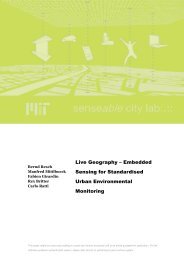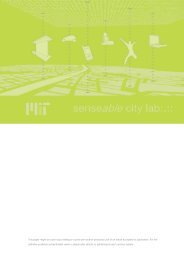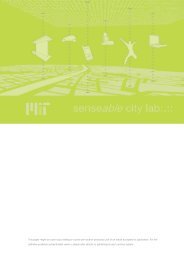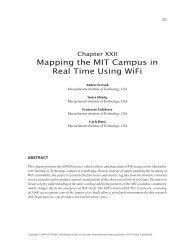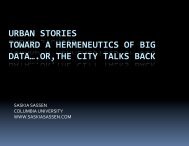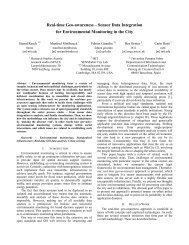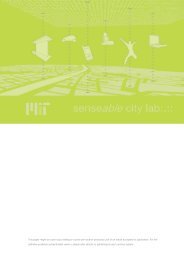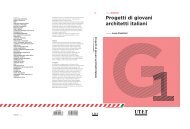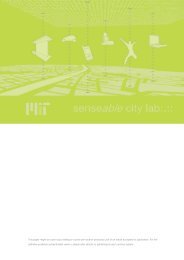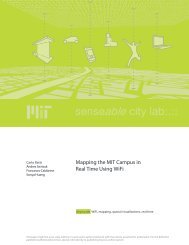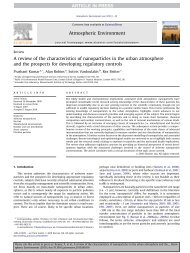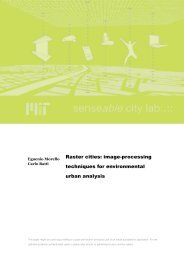Carlo Ratti - MIT SENSEable City Lab
Carlo Ratti - MIT SENSEable City Lab
Carlo Ratti - MIT SENSEable City Lab
You also want an ePaper? Increase the reach of your titles
YUMPU automatically turns print PDFs into web optimized ePapers that Google loves.
In general we distinguish two types of analyses on sequences: sequences based on a motional view (paths,<br />
such as the analysis presented above) and sequences computed on a static view (for example a panorama of 360<br />
degrees from a fixed vantage point). Static views can be evaluated calculating the maximum, minimum and<br />
average lengths of the radials of the isovist, and derived parameters from their sequences (standard deviation,<br />
etc.). This last typology of analysis based on static views is particularly indicated in dealing with Lynch’s nodes.<br />
The visual quality of nodes derives mainly from the analysis of the boundaries of these spaces.<br />
Edges<br />
Edges (shores, railroads, cuts, edges of development, walls) are linear elements not used or considered as<br />
paths by the observer. In general they are represented by boundaries between two phases: barriers or seams,<br />
important organizing features.<br />
Edges can be detected with the image processing of DEMs quickly by measuring their continuity along a<br />
motional view. This can be addressed with 2-D isovists by verifying the distribution of radial variances (regular<br />
increase or decrease) and with 3-D isovists through the computation of the variability of built barriers – in terms<br />
of square meters of vertical surfaces or number of visible voxels – on open space pixels.<br />
Landmarks<br />
Landmarks (buildings, signs, stores, mountains) are external reference points, where the observer does not<br />
enter. Landmarks are simply defined as physical objects, identified by uniqueness, specialization and singularity.<br />
They are often distant, and symbolise a constant direction. The visual element ‘landmark’ seems to be more<br />
complex to parameterise and the Space Syntax approach gave an inadequate description.<br />
The main characteristic of a landmark, such as presented by Lynch, is the ability to be visible over long<br />
vistas (far and near); in other words a landmark must be easily intercepted by different viewpoints in its<br />
environment and must represent a clear reference point. More than other visual elements, the landmark is<br />
explicitly defined by its visual components in the surroundings. The analyses presented here and based on the use<br />
of 3-D isovist calculations are particularly suitable to our purposes.<br />
First, we compute a ‘iso-visi-voxelspace’ which assigns to every voxel a value of visibility: voxels with<br />
100% visibility are the ones which are see-able from all vantage points on the ground. We can therefore consider<br />
the voxels tangent to the façades of buildings and see which buildings have a major potential for visibility in their<br />
environments.<br />
10



